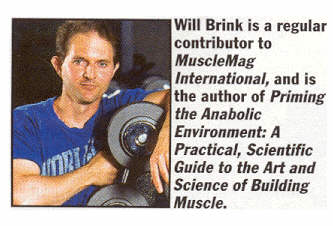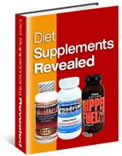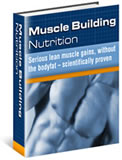Simple Weight Loss Tips No One Follows!
By Will Brink - Author of:
Diet Supplements Revealed
- The Simplest Weight Loss Tips No One Follows
I have a Cheez-It problem. You’re not listening, I really have a Cheez-It problem! I have never met a Cheez-It I didn’t like.* Some people can’t resist chocolate or ice cream, some people it’s pizza or some other food or sweet. While I enjoy all of those foods on occasion, Cheez-It’s are the food equivalent of crack cocaine for me.
It takes all my willpower to pass up the isle where the Cheez-It’s reside on the shelves at my local grocery store. My ever-loving girl friend Kimberly rolls her eyes at me in shear disgust when she sees how weak I am to the power of these little crackers, which draw me in like a cheese flavored black hole. “But you have given advice on nutrition to millions of people Will, how could you of all people be so weak willed about some little cheese flavored cracker?!” she says. I hang my head in shame and avoid eye contact with her for the rest of the day….
The point of this introduction is to point out we all have our weaknesses and we are all human…even me. I find Cheez-It’s to be cheese flavored morphine!
This small problem got me to thinking. If there is one thing I have learned after all these years of doing nutritional research, writing countless articles on the topic of nutrition, and working directly with people on their diets, it’s this: it’s rarely one single thing a person does that is sabotaging their efforts to lose fat and or gain muscle, but a bunch of little things that have an accumulated effect.
There are some amazingly simple behaviors and strategies we can all add to our nutritional goals and workout plans that will have a positive effect. Using my own addiction to Cheez-It’s as the primary example, I am going to cover a few of these surprisingly simple yet effective strategies. A few issues to keep in mind:
- Taken alone, these simple tactics will have very little effect. Used alone without any other dietary changes and an exercise plan, these strategies wont amount to much. However, as I mentioned, it’s often many minor mistakes adding up to a lack of results for people, and taken in that context, these are some simple mistakes that can be avoided, hopefully resulting in an accumulated effect in a positive direction.
- I didn’t invent any of these tips. They are some of the oldest and simplest tips you will ever read. I don’t even know who first came up with them, and I bet most people have seen these strategies in other places, such as various diet books, articles, or web sites. I do however think that they may be so old and so simple that most people with the best of intentions about their nutrition and exercise plan, don’t follow these simple concepts.
These tips are more about behavior changes and psychology then nutritional science, study results, or research. I have written many articles based on the later topics, but this is not one of those. If you are looking for more in-depth science oriented information about nutrition, supplements, and fat loss or gaining muscle, I suggest reading my ebooks on the topic on my web site.
Tip #1: never ever go food shopping hungry
This is one of the most effective strategies I know of to avoid unwanted junk and various snacks from finding their way into your shopping cart, which ends up in your home, which ends up on your butt!
Make sure to eat something before you go food shopping and you will be able to resist the junk that often finds its way into your cart. If I go food shopping without a good meal in my stomach, I often come home with a family sized box of Cheez-It’s and feel like sh*& for days after eating the entire box!
Human hunger and appetite are regulated by a phenomenally complicated set of overlapping feedback networks, involving a long list of hormones, psychological factors, and others way beyond the scope of this article. Suffice to say, we often make snap decisions and impulse purchases with certain foods due to one or more of these feedback loops being activated due to an empty stomach while we shop.
Translated, your “willpower” to resist junk foods will be much greater if you eat something healthy at least 20-30 minutes before you go food shopping. You can either plan your meal schedule so that one meal is eaten before you go shopping, or have a snack (at least 20-30 minutes before shopping) which will have the desired effects.
A yogurt with some flax oil mixed in is a good choice, as is a half cup of cottage cheese and a handful of walnuts or some other nut. A protein shake or MRP will suffice, but solid food tends to be more satiating.
Tip # 2: never keep snack foods in the house
This tip is a logical extension of tip number one. If it does not make it into your cart at the food store, it’s not in your house. However, many people use excuses like “I have snack foods for the kids” or “my spouse keeps a box of Oreo cookies in the kitchen cupboard” as reasons they can’t avoid the snacks that sneak into their diets and sabotage their efforts.
Many of the foods we eat that we know we should not be eating are based on an impulse. Impulse control goes a long way here but no one will deny it’s far harder to resist that impulse if your favorite junk food is under your nose. That’s human nature. When I have an impulse for some Cheez-it’s, I wont resist it well if it’s only a few steps to the kitchen vs. having to get in the car to go get a box.
The former I can’t resist, the latter I can. Remember an impulse is defined as “a sudden desire, urge, inclination.” That means it’s short lived and will go away given sufficient time, so it’s a matter of not having foods in your house that allow you to act on the impulse while it lasts.
As for the excuse of the spouse, kids, etc. That is more an issue between your kids and or your spouse. Should the kids be eating that stuff anyway? No! I had a client tell me one day “I keep eating hot dogs ‘cause I keep them in the house for the kids.” I said “so you’re Ok with feeding your kids foods you know to be unhealthy for you and them?” She stopped feeding her family hot dogs shortly after….
...Bottom line here is, those foods should be occasional treats for both kids and adults, not staple foods that can be found in your kitchen. It’s more an issue of teaching the kids good dietary habits young so they don’t end up overweight unhealthy adults.
As for the spouse, I like to have some chips in the house, which I can resist without a problem. That is, unlike the Cheez-it’s, I can walk past the chips without having to eat them all. I can regulate myself with them. However, Kimberly can’t. Chips are to her what Cheez-it’s are to me, so I make it a rule not to keep chips in the house.
Point being, your spouse needs to support your efforts by making some small sacrifices. If you were an alcoholic trying to avoid alcohol, you would (or at least should!) expect your significant other to not keep booze in the house. If they wont support your efforts here, then relationship counseling is in order or a long talk, and I can’t help you there; sorry!
Tip # 3: eat off of smaller plates
The first two tips are common sense, this one is less so. However, I find it helps, albeit not to a great extent. Again, how much we eat is based on many variables. One of them is the visual cues we get looking at the food we are about to eat. We are extremely visually oriented creatures and part of deciding how large an object is must be compared to other objects, in this case, the food we put on the plate in comparison to the size of the plate we put the food on. Some of you may remember this little visual test from grade school.
Looking at these two horizontal lines below, which one is longer?

Answer: both lines are identical in length. As you can see, the bottom "plate" looks longer then top "plate", yet they are the same length. It’s a visual illusion that shows how our brains are set up to interpret certain visual cues. It is my experience that people will put less food on their plate if they eat from smaller plates as a smaller plate full of food looks like much more to eat then a large plate with the same amount of food on it.
I know for myself I tend to put 2 slices of pizza on a small plate and three on a large plate! Now this is only one minor cue we have to self regulating how much food we eat, and other feedback loops (i.e., hormonal, psychological, etc.) can kick in and easily offset this strategy.
For example, you could simply come back for a second helping using the smaller plates. However, it’s my hunch (and it’s only a hunch as research is lacking here) that over the course of say a month, a person may end up taking in fewer total calories using this strategy as has been my (admittedly anecdotal) experience with both myself and the many people I have given advice to over the years.
Again, as already mentioned, taken alone, this strategy will probably have no effects on your efforts to lose fat if there is not a specific diet and exercise plan involved in the overall equation. It is however one simple small change that may improve compliancy to your efforts. It would be interesting to see a study on this, but whatever effects it may have, would be subtle and fairly small I suspect. Even so, over the course of a year say, it may help.
Tip #4: Know Thy Self
Lesson here is, we are all human and we all have our weaknesses. Trick is to know your weakness and develop strategies for coping with them. How well do you know yourself? That is, do you know what cues/triggers tend to set you off? Have you examined that issue for yourself? It’s essential to recognized the cues that sabotage your efforts. We all have them. Find yours and take steps to avoid them where possible.
For example, try making a list outlining the things you know tend to set you off and how you react to the, then add a column for how you could deal with it. For example you might write “talking to my crazy mother makes me anxious and I eat things I shouldn’t immediately after the phone conversation” which would be followed by a suggestion of steps to change it, such as “always eat a meal right before talking to mom” and “only take calls from mom when I am ready and able to deal with her” and “go for a walk immediately after talking to mom to distress and give me time to get over impulse to eat junk” and so on.
Develop coping strategies to your known triggers. I know for example going food shopping on an empty stomach means I will most probably end up with a large box of Cheez-it’s in my house. I have also found if I go shopping irritated over something I will buy more foods I don’t need as food is one of many ways we self medicate looking for some comfort. Hence the term “comfort foods” which is commonly chocolate, ice cream, and so on.
Bottom line:
- Learn what your hot buttons are that lead to a negative behavior
- Learn to identify when it’s happening
- Develop strategies for coping with it.
How do you go about doing that? As entire books have been written on that topic, my advice will fall short here. That journey is also highly individual. For some it’s working with a therapist or behavioral specialist, for some it’s reading a few good self-help type books, and for some it’s activities such as meditation, joining support groups, and others. It’s also a life long journey.
Conclusion
The purpose of this article is not as much to supply tips for success in your fat loss endeavors but to actually remind people of what is stated in the intro to this article: most people fail in their fat loss/diet goals not due to a single mistake they are making (with exceptions) but many small events that have an accumulated effect that sabotages their efforts. If the tips in this article help, all the better.
Some people are amazed how many extra calories slip into their diet from snack foods that they are not accounting for, or the fact they tend to take the elevator when they could take the stairs, and so on. 99 out of 100 times the person that says “I have tried everything and nothing works” actually translates into “I have not stayed on any one plan long enough for it to have an effect and sabotaged it with small unaccounted for negative habits and behaviors.” Now, if I can just get the funding for that adult Cheez-it rehab center I want to have built….
* Cheez-It’s are a cheese flavored cracker made by Sunshine foods and can be found on the shelves of any major food store in the US.
About the Author: Will Brink is a well known fixture in the bodybuilding and sport nutrition community and its related publications, and has authored several books. He can be contacted via his highly popular web site.

 |
Diet Supplements Revealed
By Will Brink
Independant review of the most common diet and weight loss supplements by sports nutrition expert Will Brink. Don't buy another diet supplement until you read this.
Click here for more info.
|
 |
Muscle Building Nutrition
By Will Brink & Charles Poliquin
A full nutrition program, Supplement Reviews & Training chapter by Charles Poliquin. Private members forum, everything you need to know to gain muscle.
Click here for more info.
|
| 
